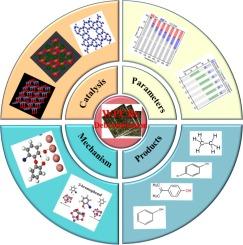Catalysis pyrolysis debromination from waste printed circuit boards: Catalysts selection, parameter effects, products, and mechanisms
IF 7.1
2区 环境科学与生态学
Q1 ENGINEERING, ENVIRONMENTAL
引用次数: 0
Abstract
As a typical e-waste, waste printed circuit boards (WPCBs), are the most valuable and hazardous components containing all the basic and precious metals as well as toxic substances such as heavy metals, brominated epoxy resins (BERs) and brominated flame retardants (BFRs). Due to their high toxicity and carcinogenicity, effective treatment of BERs and BFRs is the key to achieve the environmental-friendly recycling of WPCBs. Recently, catalysis pyrolysis has proven an efficient and promising approach to removing and recovering bromides from WPCBs. The selection of catalysts and pyrolysis parameters mutually affect the debromination of WPCBs including products and mechanisms. However, there are few studies that focus on analyzing and summarizing the above aspects. Herein, this review first introduces types of catalysts (metals, oxides, hydroxides, molecular sieve, etc.) and figures out that metals are regarded as the most suitable catalysts for WPCBs debromination due to their high efficiency and easy to recycle. Then, the interactive effects of catalyst types and pyrolysis parameters on the debromination efficiency are analyzed, and it was found that temperature ranging from 500 to 600 °C, rapid heating rates, small-size samples and in-situ metals were more suitable for debromination. Moreover, a new idea of in-situ catalysis pyrolysis using self-compositions in WPCBs is highlighted, which point out that the defects of catalysts during the reaction process could promote debromination performance. This review summarizes the key knowledge about catalysis pyrolysis debromination from WPCBs, which will devote to the recycle WPCBs more efficiently and environmental-friendly.

废印刷电路板的催化热解脱溴:催化剂选择、参数影响、产物和机理。
作为一种典型的电子废弃物,废印刷电路板(WPCBs)是最有价值和最危险的部件,其中包含所有基本金属和贵金属,以及重金属、溴化环氧树脂(BERs)和溴化阻燃剂(BFRs)等有毒物质。由于溴化环氧树脂(BER)和溴化阻燃剂(BFR)具有很高的毒性和致癌性,因此有效处理这两种物质是实现环保型木塑包装袋回收利用的关键。最近,催化热解已被证明是去除和回收多氯联苯中溴化物的一种高效且前景广阔的方法。催化剂和热解参数的选择会相互影响木塑纸板的脱溴过程,包括产物和机理。然而,专注于分析和总结上述方面的研究很少。在此,本综述首先介绍了催化剂的类型(金属、氧化物、氢氧化物、分子筛等),并指出金属因其高效和易于回收利用而被认为是最适合用于木塑纸板脱溴的催化剂。然后,分析了催化剂类型和热解参数对脱溴效率的交互影响,发现温度在 500 至 600 ℃、加热速度快、小尺寸样品和原位金属更适合脱溴。此外,还重点介绍了利用 WPCB 中的自组成进行原位催化热解的新思路,指出反应过程中催化剂的缺陷可促进脱溴性能。本综述总结了有关木塑纸板催化热解脱溴的关键知识,将有助于更高效、更环保地回收利用木塑纸板。
本文章由计算机程序翻译,如有差异,请以英文原文为准。
求助全文
约1分钟内获得全文
求助全文
来源期刊

Waste management
环境科学-工程:环境
CiteScore
15.60
自引率
6.20%
发文量
492
审稿时长
39 days
期刊介绍:
Waste Management is devoted to the presentation and discussion of information on solid wastes,it covers the entire lifecycle of solid. wastes.
Scope:
Addresses solid wastes in both industrialized and economically developing countries
Covers various types of solid wastes, including:
Municipal (e.g., residential, institutional, commercial, light industrial)
Agricultural
Special (e.g., C and D, healthcare, household hazardous wastes, sewage sludge)
 求助内容:
求助内容: 应助结果提醒方式:
应助结果提醒方式:


